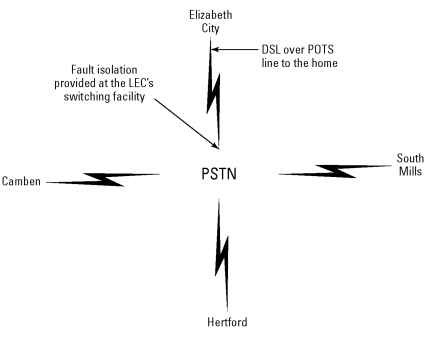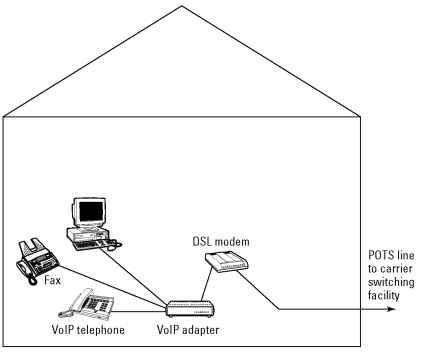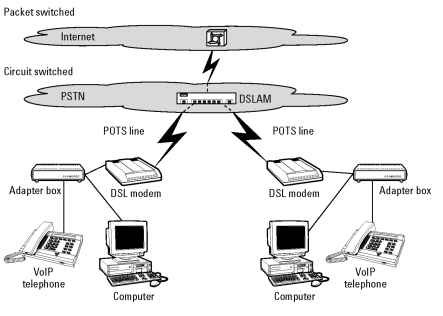DSL, described in topic 5, is a high-speed data connection method that uses the ordinary telephone lines that come into your home or business. Utilizing a star topology (see Figure 6-5), DSL provides two benefits important to VoIP: excellent fault isolation and better throughput due to less resource contention.

Figure 6-5:DSL star topology.
POTS plus!
DSL utilizes the PSTN CSI and is therefore a switched transport service. All customers must have at least basic POTS telephone service to use DSL. After you are running both POTS for telephone service and DSL for data, you can enter into an agreement with any VoIP provider to obtain VoIP services.
As with using VoIP over a cable modem connection, VoIP over DSL plans average about $50 per month for unlimited calling. (Refer to Table 6-1.) The VoIP provider either gives you a VoIP adapter box or requires you to purchase one. You can keep the POTS line service while running VoIP through the adapter box, essentially making two calls at the same time on a single phone line.
If the VoIP provider you select doesn’t have an unlimited plan, seeks to limit your minutes, or charges you by the minute, I suggest you consider a different provider.

Setting up VoIP on your DSL Line
Setting up a VoIP connection through your DSL line is similar to connecting through a cable modem. The primary differences are that you use a different adapter and that adapter connects to the DSL router or modem rather than to a cable modem. Figure 6-6 illustrates a normal VoIP connection through a DSL line.
To make your connection, follow these steps:
1. Connect the VoIP adapter box to the DSL router or modem.
2. Connect your computer to the VoIP adapter box.
3. Install the software provided by the VoIP provider.
4. Configure the telephone number and other parameters as directed by the VoIP provider.

Figure 6-6:Connecting VoIP through a DSL line.
5. Connect a microphone and speakers or plugs to a VoIP headset or handset.
6. Use the IP soft phone directly from your computer and begin to place VoIP telephone calls.
DSL does not require you to abandon your POTS telephone nor its services. Using an inexpensive splitter that plugs into the VoIP adapter box, you can continue to enjoy POTS telephony as well as VoIP. Figure 6-2 shows a fax line coming out of the VoIP adapter, but this could just as easily be a regular telephone.
Potential DSL problems
The technology used by DSL requires that the distance between your computer and the nearest carrier facility be no greater than 18,000 feet (about 3.5 miles). Distance is a factor with DSL in determining overall data speed: The shorter the distance, the better the throughput. Thus, the closer you are to the carrier facility, the better the quality of your VoIP experience. If you are near the distance limit, you may not be able to get speeds that provide satisfactory quality.
DSL does not provide enough bandwidth to support VoIP traffic for a multilo-cation company. Therefore, DSL is not acceptable as a transport for a multi-site corporate network. However, DSL is more than adequate for consumer and home-business VoIP.
VoIP over POTS
DSL runs over the same PSTN CSI that carries your POTS service. To accomplish this feat, the DSL signal is modulated at a higher frequency than the frequency used for regular voice. Analog POTS lines can’t support VoIP for reasons already outlined in topic 4, but DSL technology — piggybacked on the POTS line — can support it. DSL uses multiplexing equipment that amplifies, regenerates, and reconstructs the VoIP signals so that the packets can travel to and from the Internet in an acceptable manner.
Figure 6-7 illustrates how your VoIP packets traverse the network through your DSL connection, the PSTN, and the Internet.
A DSL line is like having two channels that are each operated using different networking techniques, both going over the same physical line. One channel is your analog POTS line, and the other is the digital DSL line.


Figure 6-7:Sending VoIP packets through a DSL connection.
